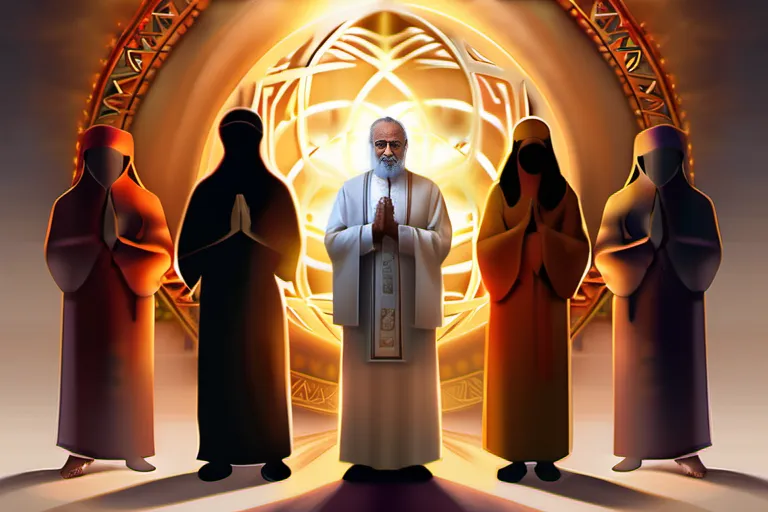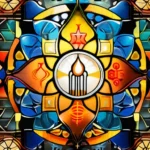Exploring the Major Faiths and Their Global Impact
This article delves into the world’s most practiced religions, providing an overview of their history, beliefs, practices, and global distribution. From Christianity to Islam, Buddhism, Hinduism, and more, we’ll uncover the unique aspects that make each faith significant.
The History and Evolution of Christianity
The history and evolution of Christianity: it’s like tracing the roots of a mighty tree that has spread its branches across continents, spanning centuries. Imagine Christianity as a river, originating from the shores of Judea, where Jesus Christ is believed to have walked, taught, and performed miracles. But what sparked this divine stream? Many believe it all began with the teachings of Jesus during his lifetime around 2000 years ago.
But let’s zoom in: what made these early followers so committed that they faced persecution and torture? Was it just the promise of an afterlife, or was there something more profound at play? Perhaps it was the belief in a new covenant—a relationship with God that transcended societal norms and expectations. This new faith quickly attracted followers who saw in Jesus’ teachings a message of love, forgiveness, and equality.
The spread of Christianity wasn’t just about conversions; it was also about adapting to different cultures. Just as a vine weaves through the cracks of a wall, Christianity wove its way into diverse societies. By the 4th century, Emperor Constantine’s recognition of Christianity marked a pivotal moment, allowing the faith to flourish and spread like wildfire.
During the Middle Ages, Christianity was both a unifying force and a source of division. The Crusades, though often violent and bloody, also played a role in spreading Christian influence across Europe, Asia, and Africa. But how did the Protestant Reformation change this landscape? Wasn’t it like a powerful storm that shattered the old religious order into smaller, more fragmented pieces?
The history of Christianity is replete with contradictions: it has been a beacon of hope for many but also the pretext for endless conflicts. It’s hard not to wonder how different the world would be if this faith had never taken root. Yet, here we are, still grappling with its profound impact on morality, art, politics, and culture.
From its humble beginnings in a small village to becoming the largest religion globally, Christianity has indeed traversed a long and winding road. Its journey is a testament to human resilience and faith’s enduring power.
Islam: Beliefs, Practices, and Global Presence
What exactly does Islam mean to you? A religion that originated in Mecca over 1,400 years ago and has since grown into one of the world’s largest faiths? Imagine a river, its source rooted deeply in the teachings of the Prophet Muhammad, flowing through continents, shaping cultures, and influencing societies. This chapter will delve into the fundamental beliefs, practices, and geographical distribution of Islam, as well as its profound impact on culture and society.
At the heart of Islam lies the belief in one God (Allah) and the acceptance of Muhammad as His final prophet. The Quran, considered the literal word of God, is central to Islamic teachings, guiding believers through a path of righteousness, justice, and moral conduct. But what does this actually mean in practice? Muslims are expected to perform five daily prayers, fast during Ramadan, give to charity (zakat), make a pilgrimage to Mecca if able (hajj), and live by the Five Pillars of Islam.
Geographically, Islam is like a vast tapestry, woven across continents. From the bustling streets of Istanbul, Turkey, to the bustling marketplaces of Indonesia, it has left an indelible mark on cultures worldwide. In fact, Muslims now form the majority in more than 50 countries, making up nearly one-fifth of the world’s population. This presence is not just numerical; Islam influences everything from art and architecture to politics and daily life.
So how does Islam impact culture? Consider the intricate geometric patterns found in mosques or the rich tradition of calligraphy. These elements, deeply rooted in Islamic teachings, have become symbols of cultural identity and pride. Moreover, the concept of ‘justice’ (adl) is central to Islam, influencing legal systems and social policies across Muslim-majority nations.
In essence, Islam is more than just a religion; it’s a way of life that permeates every aspect of society. As we explore its beliefs and practices, let us also recognize the profound influence it has had on global culture and civilization. From its origins in the Arabian Peninsula to its current presence around the world, Islam continues to shape our understanding of faith, community, and humanity.
Buddhism: The Path to Enlightenment
Imagine walking through the serene gardens of ancient India, where the whispers of enlightenment echo through time. Buddhism, one of the world’s largest religions, began its journey in these very landscapes around the 5th century BCE. It was a path forged by Gautama Buddha, who sought to find an end to human suffering and found it not in grand temples but within his own heart and mind.
How could a man sitting under a Bodhi tree, meditating through the night, change the world? His teachings, known as the Four Noble Truths and the Eightfold Path, offered a practical guide to living a life free from suffering. Buddhism teaches that everything is impermanent, an insight that can be both comforting and challenging for followers to embrace.
As Buddhism spread across Asia, it adapted to local cultures and beliefs, creating various schools like Theravada, Mahayana, and Vajrayana. Each school offers its unique interpretation of Buddha’s teachings, much like how different maps guide us through the same territory in distinct ways. In Japan, Buddhism intertwined with Shinto practices; in Tibet, it merged with indigenous beliefs to form a spiritual tradition rich with symbolism and ritual.
Through meditation, chanting, and monastic life, Buddhists seek to cultivate wisdom, compassion, and understanding. The practice of mindfulness encourages individuals to be present in the moment, observing their thoughts without judgment—a powerful tool in modern society’s fast-paced world.
Today, Buddhism continues to evolve and inspire people across continents. Its principles offer a profound insight into human nature and the quest for inner peace. Could it be that this ancient path holds the key to a more harmonious and compassionate global community?
Hinduism: The Oldest Religion on Earth
Hinduism, often described as the oldest living religion on Earth, carries within its fabric a tapestry of myths, rituals, and beliefs that have shaped the cultural landscape of India for millennia. But what exactly is Hinduism? Is it just another faith or does it hold a unique position in human history?
At its core, Hinduism is not a single religion with one definitive set of doctrines but rather a diverse array of traditions and philosophies that share common roots and themes. Its ancient texts, the Vedas, are as much a cornerstone for scholars as they are a source of spiritual guidance for millions of devotees worldwide.
One can’t delve into Hinduism without mentioning its pantheon of gods and goddesses. From the revered Brahma, the creator, to Vishnu, the preserver, and Siva, the destroyer-rebirth, each deity represents a facet of the divine and plays a crucial role in the cosmic dance that is Hindu cosmology.
The practice of Yoga, with its intricate postures and meditative techniques, serves not only as physical exercise but also as a means to spiritual liberation. The concept of dharma, or one’s duty or righteousness, guides individuals in their daily lives, influencing everything from personal conduct to societal norms.
Moreover, Hinduism’s influence on Indian culture is profound. From the intricate designs of kundalini energy channels depicted in temples to the vibrant festivals like Diwali and Holi, which light up the nation with colors and lights, it weaves a rich cultural fabric that resonates across generations.
As you explore Hinduism, consider how its ancient wisdom continues to guide and inspire not just Indians but people around the globe. Is it merely a relic of the past or is there something timeless about its teachings that speaks directly to our modern world?
For many, Hinduism is more than a religion—it’s a way of life, a path toward understanding one’s place in the universe and the interconnectedness of all beings. In a world often torn by divisions, perhaps it holds lessons on unity and harmony worth reflecting upon.
Hinduism: The Oldest Religion on Earth is not just about ancient texts and deities but also about enduring traditions that continue to shape human thought and existence in profound ways.
Other Major World Religions
Now that we’ve delved into Hinduism, let’s explore some other significant world religions, each offering its own unique perspective on life and the divine.
First up is Sikhism, a monotheistic religion founded in the 15th century by Guru Nanak. Imagine walking through the serene streets of Punjab; you’ll find many Sikhs wearing their distinctive turbans and beards, all united by their belief in one God. What exactly does it mean to believe in one God? How can we reconcile this with the multitude of gods worshipped in Hinduism or the polytheistic traditions found in ancient Egypt?
Sikhs also follow a strict code of conduct known as the Five Ks, including keeping uncut hair (Kesh). This practice is both a symbol and a statement, much like wearing a cross for Christians or donning a hijab for Muslims. Why do these symbols hold such profound significance? Could they be seen as modern-day representations of ancient beliefs?
Next, we have Judaism, the oldest surviving monotheistic religion. It’s fascinating to think about how Judaism has shaped not only its own practices but also those of other major religions like Christianity and Islam. What makes a people’s religious tradition so influential? Could it be their long-standing commitment to faith and family, or perhaps their historical struggles that have forged a strong sense of identity?
The Bahá’í Faith is another interesting religion to explore. Founded in the 19th century by Bahá’u’lláh, this faith promotes unity among all people regardless of race, gender, or class. It’s like having a big family where everyone is welcome, no matter their background. How can such inclusivity be achieved? What barriers do we face when trying to unite humanity under one roof?
Each of these religions—Sikhism, Judaism, and Bahá’í—brings its own unique perspective to the table. They challenge us to think beyond our own traditions and consider the vast tapestry of human belief systems. Just as a garden thrives with diverse flowers, so too does our understanding of religion deepen when we embrace this diversity.
The Intersection of Religion and Culture
Have you ever wondered how religion intertwines with culture, shaping societies and influencing daily life? The relationship between these two concepts is often depicted as a complex dance, where one step leads to another in a perpetual motion. In many parts of the world, religious practices are deeply rooted in cultural traditions, creating a tapestry that defines the essence of a community.
Take for example, India, where Hinduism permeates nearly every aspect of life. The concept of dharma, or duty and righteousness, guides not only spiritual practices but also social norms and family traditions. Festivals like Diwali are celebrated with great enthusiasm, blending religious rituals with community feasts that reflect the cultural richness of the nation.
Similarly, in Japan, Buddhism and Shintoism coexist, creating a unique spiritual landscape. Shinto shrines can be found throughout the country, often integrated into everyday life through local festivals and ceremonies. The blend of these religions influences everything from architecture to art, reflecting the deep cultural reverence for nature and spirituality.
In Mexico, the Day of the Dead is a prime example of how religion intersects with culture. This holiday honors deceased loved ones through vibrant traditions that combine indigenous beliefs with Catholic influences introduced by Spanish colonizers. Altars are adorned with marigolds, candles, and photographs, creating an intimate connection between the living and the dead in a way that is deeply rooted in cultural heritage.
These examples illustrate how religion shapes culture but also how culture enriches religious practice. It’s a dynamic relationship where traditions evolve, adapting to new contexts while maintaining their core values. Whether it’s the vibrant colors of Diwali, the serene beauty of Shinto shrines, or the respectful reverence during Day of the Dead ceremonies, each culture brings its unique flavor to religious practices.
In exploring how religion and culture intersect, we gain a deeper understanding not only of faith but also of the intricate web that binds people together across generations. It’s this interplay that makes every culture rich in its own way, offering insights into human spirituality and community life.
Conclusion
 By understanding the diversity and commonalities among these religions, we gain a deeper appreciation for cultural differences and shared human experiences.
By understanding the diversity and commonalities among these religions, we gain a deeper appreciation for cultural differences and shared human experiences.











